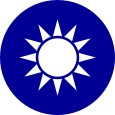| 監察院 Jiānchá Yuàn (Mandarin) Kàm-tshat Īnn (Taiwanese) Kam-chhat Yen (Hakka) | |
 Emblem of the Control Yuan | |
| Agency overview | |
|---|---|
| Formed |
|
| Preceding agency |
|
| Jurisdiction | Taiwan |
| Status | Parliamentary institution suspended since 1993 |
| Headquarters | Zhongzheng District, Taipei |
| Agency executives | |
| Key document |
|
| Website | www.cy.gov.tw |
Control Yuan 監察院 | |
|---|---|
| Type | |
| Type | |
| History | |
| Founded | 4 June 1948 |
| Disbanded | 1 February 1993 |
| Structure | |
| Seats | 178 |
Length of term | 6 years |
| Authority | Constitution of the Republic of China |
| Elections | |
| Indirect election | |
| Meeting place | |
 | |
| Control Yuan Building, Nanking (1948-1950) Control Yuan Building, Taipei, Taiwan | |
| Constitution | |
| Constitution of the Republic of China | |
| Control Yuan | |||||||||||||||||||||||||||
|---|---|---|---|---|---|---|---|---|---|---|---|---|---|---|---|---|---|---|---|---|---|---|---|---|---|---|---|
| Traditional Chinese | 監察院 | ||||||||||||||||||||||||||
| Simplified Chinese | 监察院 | ||||||||||||||||||||||||||
| |||||||||||||||||||||||||||
 |
|---|
|
|
The Control Yuan is the supervisory and auditory branch of the government of the Republic of China, both during its time in mainland China and Taiwan.[1]
Designed as a hybrid of auditor and ombudsman by Taiwanese law, the Control Yuan holds the following powers:[2]
- Impeachment: The Control Yuan has the power to impeach government officials. Successfully impeached cases then go to the Disciplinary Court of the Judicial Yuan for adjudication.[3] Impeachment of the President and the Vice President of the Republic follows a different procedure and does not go through the Control Yuan.
- Censure: The Control Yuan also has the power to censure a government official. The censure is sent to the official's superior officer.[4]
- Audit: The Executive Yuan (cabinet) presents the annual budget to the Control Yuan each year for audit.
- Corrective Measures: The Control Yuan, after investigating the work and facilities of the Executive Yuan and its subordinate organs, may propose corrective measures to the Executive Yuan or its subordinate organs for improvement after these measures are examined and approved by the relevant committees.
According to the current Constitution, the Control Yuan shall consist of 29 members. One member shall be the President of the Control Yuan, and another shall be the Vice President. All members, including the President and Vice President of Control Yuan, shall be nominated by the President of Taiwan and approved by Legislative Yuan (the parliament of Taiwan). Members serve with a term limit of six years.
Prior to constitutional reforms in the 1990s, the Control Yuan, along with National Assembly (electoral college) and the Legislative Yuan (lower house) formed the national tricameral parliament. It functioned similarly to an upper house of a bicameral legislature, though it formed its own separate branch and was indirectly elected by provincial or municipal legislatures with 178 senators elected.[5]
- ^ Jacobs, Andrew (2009-08-23). "Taiwan's Leader Faces Anger Over Storm Response". The New York Times. ISSN 0362-4331. Archived from the original on 2020-08-17. Retrieved 2020-08-16.
- ^ See Additional Articles of the Constitution art. 7, available at "Additional Articles of the Constitution of the Republic of China (Taiwan)". July 10, 2005. Archived from the original on August 14, 2022. Retrieved September 14, 2020.
- ^ 公務員懲戒法 [Public Functionary Disciplinary Act] (23) (in Chinese). Legislative Yuan. 20 May 2015. Archived 9 March 2021 at the Wayback Machine
- ^ "Censure". The Control Yuan of the Republic of China. Archived from the original on 9 June 2020. Retrieved 10 June 2020.
- ^ Ma, Herbert H. P. (1963). "Chinese Control Yuan: An Independent Supervisory Organ of the State". Washington University Law Review. 1963 (4): 26. Archived from the original on 2021-04-21. Retrieved 2021-04-01.
